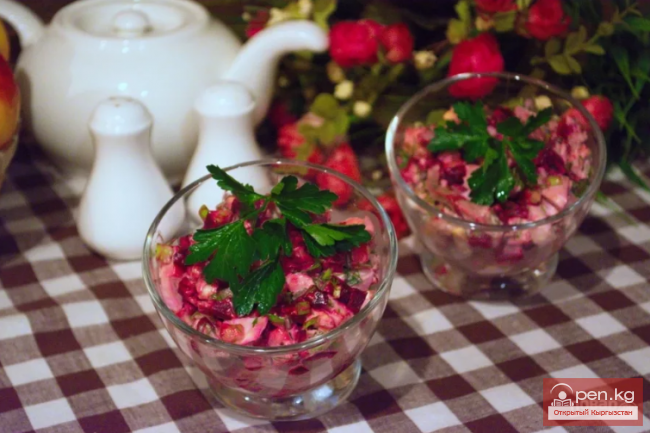Batta, also known as -ganfan, also – lagman with rice
Batta is certainly not lagman. The only similarity it shares with lagman is the separate cooking of the sauce and the grain component, while the sauce itself, in terms of preparation technology, resembles lagman vadju. At the same time, a number of fundamental differences from lagman (not to mention that lagman uses noodles instead of rice) makes batta – this somewhat forgotten dish of Kyrgyz cuisine with undoubtedly Uyghur-Dungan roots – completely independent.
In terms of ingredients, batta is somewhat simpler than lagman. For the sauce (based on 4 servings), you need to take:
1. 300 grams of lamb or beef
2. One medium radish (green, Margilan. A suitable substitute can be daikon radish or even carrot)
3. Two medium onions
4. Three ripe tomatoes or 150 grams of canned tomatoes in their own juice (out of season)
5. About 100 grams of vegetable oil, half of which will be used for making the sauce, and half for the rice.
6. One sweet (bell) pepper
7. Two to three cloves of garlic.
8. A few pods of green beans. In its Asian form, few lagmans are made without it. Among Uyghurs, this type of bean is called “jandu,” while among the Chinese, it’s known as “snake beans,” but overall it’s still the same milk-ripe beans in pods, just viewed from the side. Its purpose is to give the sauce a bean flavor, which is wonderful in itself!
9. Some greens for garnishing the dish, salt, a teaspoon of ground coriander, and for those who wish – hot pepper to taste.
As for the rice (about 200 grams), it is important to use varieties suitable for making a fluffy dish, not forgetting about their taste qualities. What the specific variety is called is a secondary matter.
For batta, the rice is prepared separately and in different ways. It can simply be boiled, or it can be sautéed beforehand (before boiling). In this case, it acquires more pronounced flavor nuances. To do this, the rice should be rinsed in several waters, drained in a colander to remove excess moisture, and then poured into a cauldron or pot with pre-heated vegetable oil, no more than 50 grams.
Next, you will need to actively work with a slotted spoon or spatula to ensure that, on one hand, the rice does not clump together, and on the other hand, it browns relatively evenly.
After browning, the rice can be poured with a large (about two liters) amount of boiling water, add a couple of pinches of salt, and cook, stirring, almost until fully cooked.
Now it can be removed with a slotted spoon to a suitable bowl, seasoned with half a teaspoon of ground coriander, and covered with a lid for a while to continue steaming.
You can start preparing the actual vadju – the sauce for this rice. Since it cooks relatively quickly, it’s better to slice the meat thinly, cut the onion into thin rings, the radish into strips, two to three cloves of garlic into crosswise slices, and chop the tomatoes, green beans, and sweet pepper as you like.
For sautéing the ingredients, choose a pot suitable for the cooking speed – a cauldron or wok, and quickly fry the meat in about 50 grams of well-heated oil.
Then add the radish and green beans, not worrying too much about their sautéing. The main thing is that the radish softens significantly.
Next, add the bell pepper – literally for two to three minutes of frying while stirring the ingredients intensively.
Then, add the sliced onion and garlic, which should be sautéed only until the onion becomes translucent – also for two to three minutes.
Finally, add the chopped tomatoes, which usually take a bit longer to sauté, as you need to evaporate the excess moisture that appears and slightly scorch the pieces of tomato.
In the original Dungan version of this dish, the sauce for the rice is ready if it is seasoned with salt and half a teaspoon of ground coriander. If you remove this mass from the pot, transfer it to a deep bowl, and let it sit covered for about 10 minutes, it will undoubtedly release enough moisture to be considered a sauce.
In the Central Asian versions, that is, in batta itself, a certain amount (in this case, about a liter) of hot water is added, and the cooking of a full (in volume) sauce continues for about half an hour – at a very low simmer. And only at the very end is it adjusted for salt and spices. In both cases, these sauces are similar in flavor nuances, with the only difference being the amount of moisture, tactile sensations (in the Dungan version, the vegetables remain half-cooked), and slightly increased cooking time.
Batta, like lagman, is usually served in large bowls or deep plates, where rice is first placed, and then a generous amount of sauce is added, so the dish resembles a thick soup. It is advisable to top it with some fresh chopped greens and garlic. If there is fresh jussai (also known as wild onion), which is widely used in both Kyrgyz and Dungan cuisine, it is better to replace the greens and garlic with it.
Soups of Kyrgyzstan













































